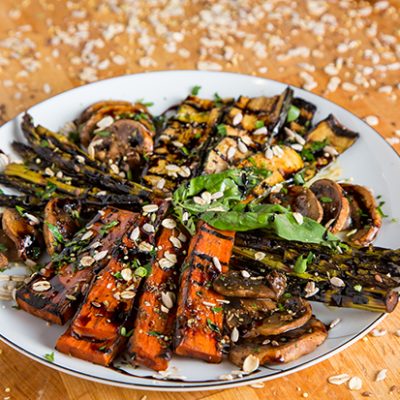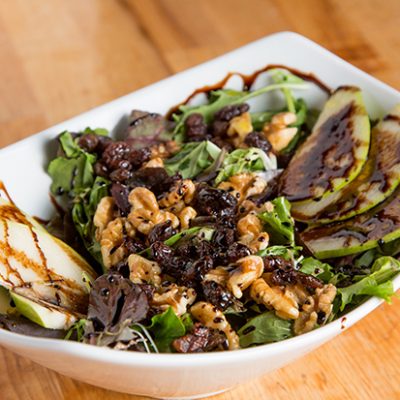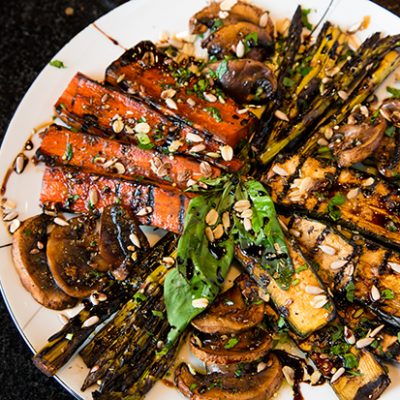
A PASSION FOR HEALTHIER EATING MOTIVATED THIS LOCAL ENTREPRENEUR TO DEVELOP A LOWER-FAT BALSAMIC GLAZE, AMONG OTHER INNOVATIONS
by Taylor Hersh
While growing up, Giuseppe Generoso, founder and CEO of Roso Foods in Charleston, was drawn to the stove where his mother stood preparing meals for the family. From fancy to simple, he recalled, she inevitably began and ended with quality ingredients, an insistence that over time became gospel to young Giuseppe.
Armed with that passion, Generoso began his first job in the restaurant business at the age of 15. Of all the sights and sounds experienced, the most striking memory, he said, was the simple joy of diners at they tucked in…there was something elemental about it. As time went on, Generoso dreamt of owning his own restaurant one day…and that vision eventually became brick-and-mortar reality in the form of a gamut of culinary related enterprises: Royal Crown & Royal Cucina (SI), Artisan Bakers Group (SI), Yeasty Secrets (SI), Paneantico (BK), Green Fig Bakery Café (BK), and Artisan Food Valley (BK).
As the owner formulated the plans for each of these businesses in Staten Island and Brooklyn, he considered the struggle people go through to eat heartily and healthy simultaneously. It was a challenge he had dealt with, having long considered healthy, fat-free foods to be— put mildly—dull.
Gradually, studiously, Generoso created a roster of dishes that had little or no fat, yet still encompassed the same flavors he grew up with. One of the most critical components of this new thinking was taking advantage of the flavor power of balsamic vinegar—particularly ways to use it and other zesty favorites in healthier, low-fat ways. The first step was learning to concentrate its flavor, a process that took months of trial and error. Generoso put months of work into the project, and the result is his own brand entirely—Roso Balsamic Vinegar Glaze.
The carefully selected grapes for the glaze are grown in Modena, Italy. Aged to achieve peak flavor, they are then reduced for the boldest taste possible. The glaze, according to Generoso, is particularly applicable to salads, as it coats the lettuce like oil, thus saving the application of as much olive oil.
Other foods such as sandwiches, meats, cheeses, and fruits can also be brought to another level with a touch, he added. The glaze became a highlight on all of Generoso’s menus—from salads to sandwiches to sauces. As demand grew, he elected to expand its reach from his businesses to home shelves — bottling it so customers could purchase directly.
Other restaurants began ordering the glaze in large quantities to use in their own dishes, recognizing its potential to make a variety of dishes take on new life. With its blend of Lambrusco and Trebbiano grapes and wood barrel aging process, the result has an earthy and not overly biting sourness, along with a texture and aroma unique among the plethora of balsamic related products.
Generoso added that the glaze is currently distributed at an array of locations in Staten Island, Brooklyn, New Jersey, and Long Island…and bottles and cases are additionally available for online purchase. He is also initiating plans to introduce new products in the near future. •
The story of balsamic
The same country that brought such notable Renaissance artists as Michelangelo and Leonardo da Vinci also provided a unique take on a product that has been used on kitchen tables for thousands of years, namely vinegar. “Balsamic” vinegar can only currently be produced in the regions of Modena and Reggio, and its history dates to at least 1046, when a bottle was reportedly given to Emperor Enrico III of Franconia as a gift. In the Middle Ages, it was used as a disinfectant, and also had a reputation as a miracle cure, good for everything from sore throats to labor pains.
What makes a vinegar balsamic? The process involves an aged reduction of white sweet grapes (Trebbiano for red and Spergola for white sauvignon) that is then boiled to a syrup. The grapes are cooked slowly in copper cauldrons over an open flame until water content is reduced by more than 50%. The resulting “must” is placed into wooden barrels and an older balsamic vinegar is added to assist in a cetification. Each year, the vinegar is transferred to different wood barrels so that the vinegar can obtain flavors of the different woods. (The only approved woods are oak, cherry, chestnut, mulberry, acacia, juniper, and ash.) The age of vinegar is categorized as young (from 3 to 5 years maturation); middle aged (6 to 12 years); and the highly prized very old, which is at least 12 years, and up to 150 years old.
—Adapted from copy courtesy of gourmetblends.com
Roso Foods 708 Sharrotts Road, Unit 2 / 718.605.0122 / rosofoods.com
Paneantico Bakery Cafe 9124 3rd Ave., Brooklyn / 718.680.2347
Royal Crown Bakery 1350 Hylan Boulevard / 718.668.0284







